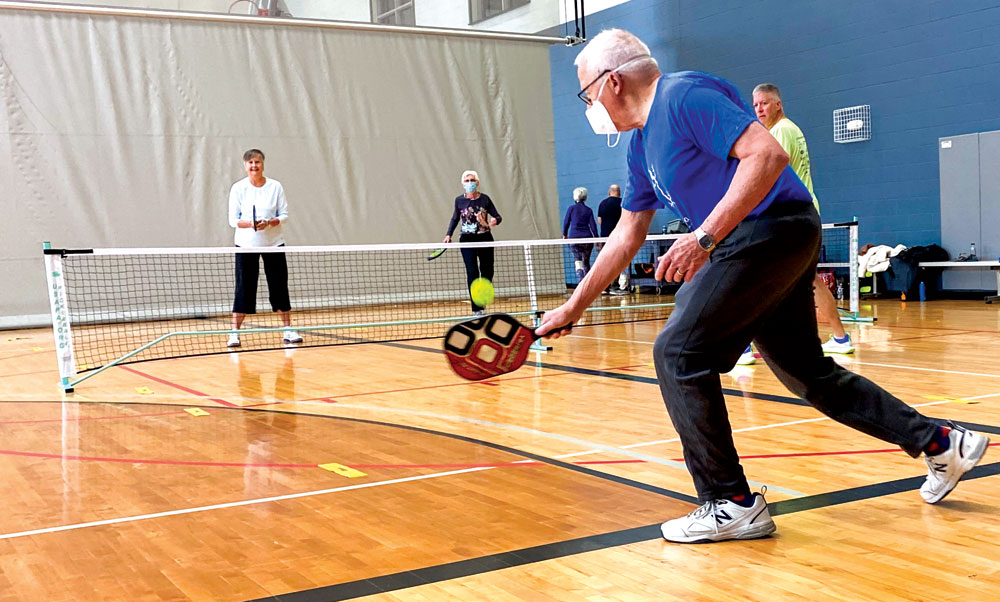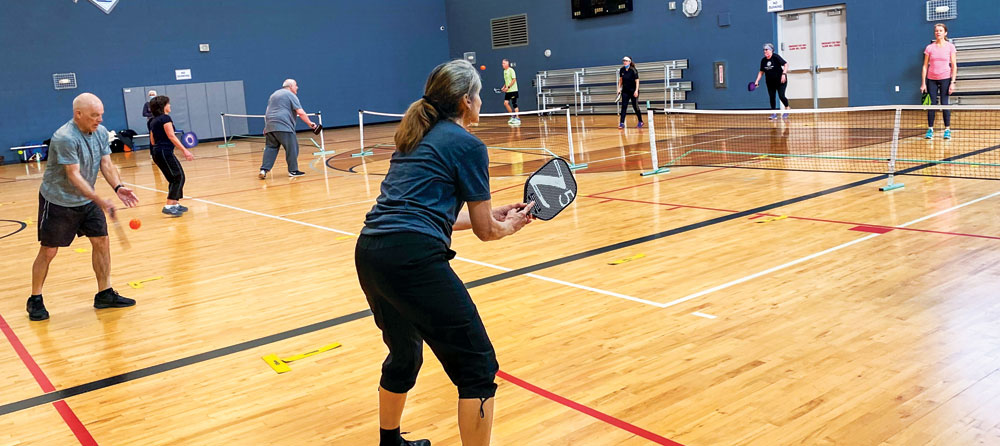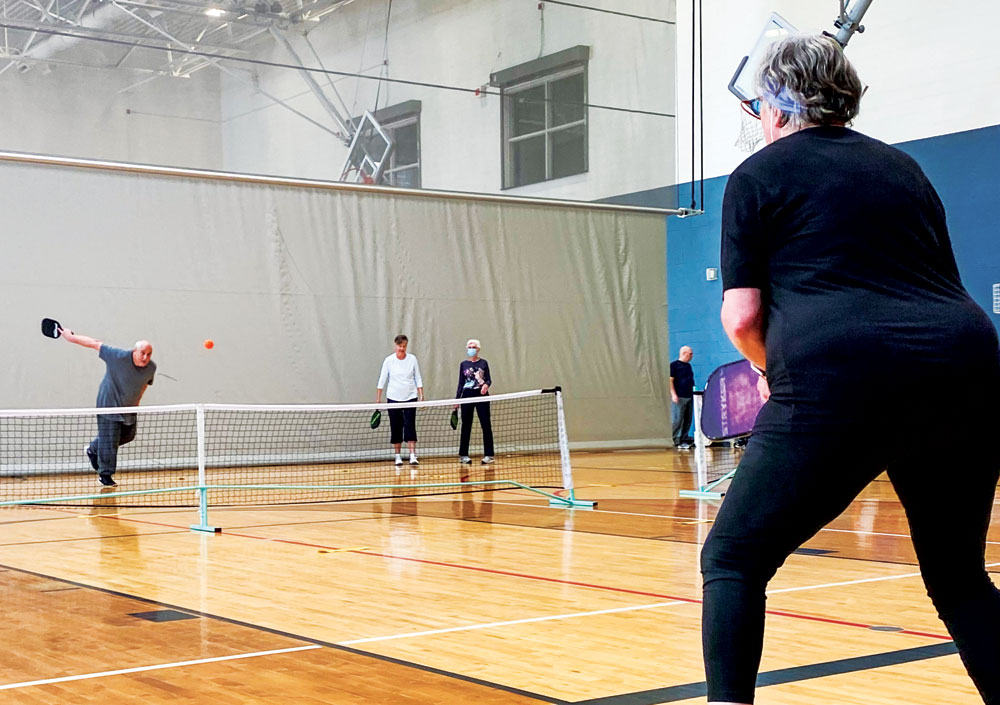
Seventy-nine year old Ken Fox (foreground) plays pickleball several times a week, despite having Parkinson’s disease. He says the sport makes him feel younger and more fit. Jan Devor (white shirt) volunteers twice a week at the Central Park Recreation Center, teaching new players the rules of the game.
It may have a funny-sounding name, but it’s the fastest growing sport across the nation and in Denver. Pickleball, which is a cross between tennis and ping pong, is delighting players of all ages even as it’s causing challenges for municipal recreation departments. “I haven’t seen anything take off this fast and get so many people so excited,” said John Martinez, Denver’s deputy executive director of recreation.
The paddle sport, which was created more than five decades ago, uses a court that is smaller than a tennis court and is usually played as doubles. It is popular among active senior citizens, but also among millennials and even children. Over the past five years, Denver Parks and Recreation has developed seven outdoor locations with 28 pickleball courts and 18 indoor locations with 45 courts.

Arslan Guney (facing camera) spends several days a week at Denver rec centers, volunteering his time to teach new players the fundamentals of pickleball.
And still it’s not enough. Perhaps nowhere is that more evident than in Northeast Denver where players are clamoring for more court time. Martinez says he hears the pickleball players “loud and clear” but he must manage multiple recreational interests in determining where to invest infrastructure dollars. “We’ve tried to keep up with demand. We’ve built pickleball courts that were old tennis courts. It’s a community-driven process, but we have to find balance between tennis, basketball, volleyball, other recreational programs and pickleball.”
Jan Devor is part of an active pickleball community in Central Park that is advocating for additional resources. She’s already had some success. Devor and her friend, Dorothy Schepps, convinced Central Park rec center officials to set up six pickleball courts in the gym every Monday and Wednesday from 9 a.m. to 1 p.m. The two women said they would volunteer to give free, informal lessons during the first two hours of the pickleball sessions. They had no idea it would be such a success. “We have lots of people who are retired, but we also have younger people who come on their lunch break and college kids who come when they’re home on vacation. Most say they’ve been wanting to learn but they didn’t know where to go,” says Devor.

For four hours every Monday and Wednesday morning, the Central Park Rec Center gym is transformed into 6 pickleball courts. Free instruction for beginners is offered during the first two hours.
Arslan and Linda Guney moved to Denver from the East Coast in 2017 to be near grandchildren. They had never heard of pickleball but were trying to meet new people, so they stopped in the rec center and were introduced to the sport by Devor and Schepps. Pickleball quickly became an obsession for them. They’ve made dozens of new friends in the process and now help coordinate the free instruction. “It’s come full circle. Now we’re introducing it to other people,” says Linda.

Pickleball players at the Central Park Rec Center say the cloth markers that delineate the court boundaries pose a tripping hazard. They want the center to paint the kind of permanent lines that are found at other rec centers.
Seventy-one-year old Arslan says he’s become addicted to the fast-paced game and plays five to seven days a week, often for three to four hours at a time. He’s not surprised at the sport’s meteoric rise. “Pickleball has a short learning curve. People can learn to play in two hours. You get exercise, but most importantly, it’s the social aspect that really keeps people coming back.”
In fact, it’s that community-building aspect that players repeatedly mention when they talk about what they love about the game. Unlike tennis, where players usually arrive at the courts knowing who they are going to play, with pickleball, players can show up alone and instantly get into a rotation of playing with new teams. The games are relatively short. The first team to score 11 points—with at least a two-point margin—wins, so often it means a player can play four to five games with several new partners and new opponents in just two hours.
Those quick games are one of the things that appealed to Joey Holland, who has organized a Central Park pickleball Facebook page. As a 40-something, she is a bit younger than many of the players at the Central Park rec center, but she decided to take up pickleball when she was recovering from a broken ankle. Soon she was playing two to three hours every day and her ankle pain disappeared. “I’m so inspired by the older people who play. I watch one 82-year old woman who is out there playing all of the time. That’s my dream: to be 82 and flying around the court like that.”
Seventy-nine-year-old Ken Fox is also an inspiration to many. He has been playing pickleball regularly for five years, despite the fact that he has Parkinson’s disease. He credits the sport for keeping him active. “It helps me stay younger and more fit. And as far as Parkinson’s is concerned, I know that exercise helps me feel better.”

Pickleball players say that the sport has become so popular because it is easy to learn and encourages a lot of social interaction.
Arslan Guney is thrilled that pickleball continues to attract so many new people, but he does worry about the shortage of adequate facilities to meet their needs. He and others who play regularly at the Central Park rec center are frustrated that the city won’t paint permanent lines on the gym floor to clearly mark the pickleball court. Instead, short cloth strips are put down as temporary markers. Guney says they pose a hazard since people can trip or slip on them. “They curl up. They’re always moving so you really have to watch where you step.”
John Martinez says that a safety inspector for the city has determined that the temporary strips are safe and that permanently painted lines would be confusing when the gym is used for volleyball or basketball.
Guney says he plans to continue to lobby city officials to build more courts in Northeast Denver especially if the indoor courts are taken away during the summer months. “There are 40,000 people who live in the Central Park neighborhood and we only have six outdoor courts. That’s not nearly enough.”
Front Porch photos by Christie Gosch




Skateboarding is not a crime but apparently “Pickleball is a Crime”?!? Denverite just reported “…. man was banned from all of Denver’s rec centers. Pickleball play was suspended at the Central Park center…” apparently because of the wrong decision by the man who sharpie marked the boundaries for the Pickleball court that Denver Park and Rec (DPR) refused to mark for the players.
Seriously, DPR can be real cool and cutting edge or can be real kooks.. Lately DPR has been real kooks and not just regarding pickleball…. Time the citizens step up to DPR and demand a meeting w/ Director Happy Haynes to allow suggestions, different ideas, and voices heard. DPR serves the community, the community does not serve DPR…. Come on DPR get with it!!!!
Here is a link to our response to this story which will also appear in our April edition: https://frontporchne.com/article/central-park-picklebrawl/
Is it true that Central Park Recreation Center is harassing a 72 year old pickleball volunteer just for remarking the floor where the previous pickleball mark had disappeared, and called described it as an act of “vandalism” and closed down the court? Where are our community’s priorities right now?
YES! This is true and totally shameful!!
Dener Parks and Rec have put out an ARREST WARRANT against Arslan Guney for putting some small markings on the gym floor for pickleball courts. Horrible harassment!
Read full article in Denverite at:
https://denverite.com/2022/03/22/pickleball-prosecution-arrest-warrant-issued-for-central-park-man-accused-of-drawing-pickleball-markings-on-rec-center-court/
Spread the word! This is total BS!!
Here is a link to our response to this story which will also appear in our April edition: https://frontporchne.com/article/central-park-picklebrawl/
The lot of land North of Prairie Meadow Parkway between Dallas and Clinton, is owned by Denver Parks and Rec. It has remained undeveloped since the neighborhood around it was built, five years ago. I think this would be a wonderful spot to add more pickle all courts and possibly other Parks and Rec facilities.